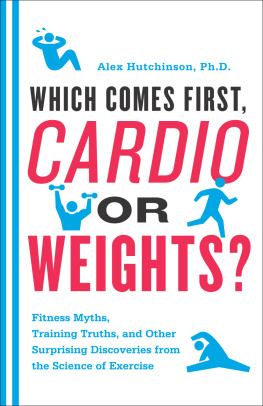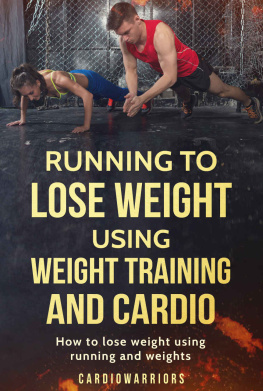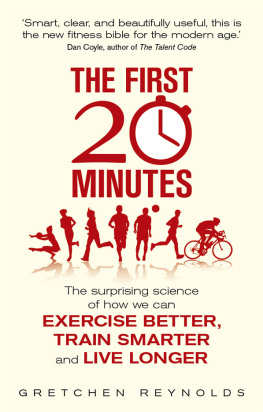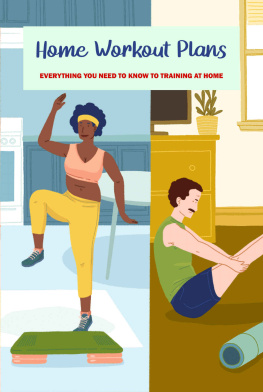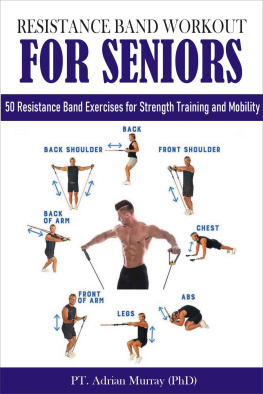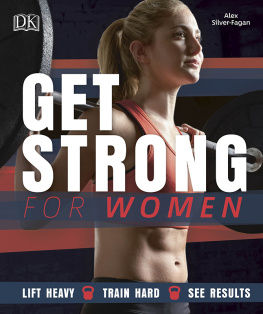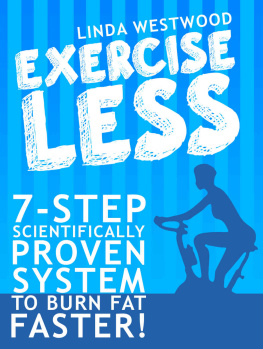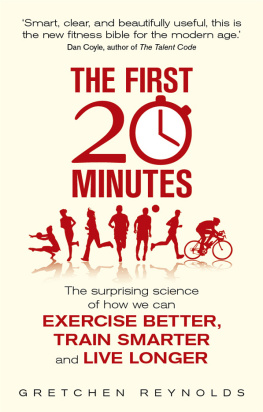Alex Hutchinson, Ph.D.
WHICH COMES FIRST,
CARDIO
OR
WEIGHTS?
Fitness Myths,
Training Truths, and Other
Surprising Discoveries from
the Science of Exercise

For Lauren
Contents
W HEN A RESEARCH INSTITUTE in La Jolla, California, issued a press release with the provocative title Exercise in a Pill in the summer of 2008, it wasnt hard to predict the headlines that would be splashed across the next days newspapers. Trying to reap the health benefits of exercise? Forget treadmills and spin classes, the release proclaimed. Researchers at the Salk Institute for Biological Studies may have found a way around the sweat and pain. Feeding a drug called AICAR to a group of mice for four weeks allowed them to run 44 percent longer than drug-free mice, the new study foundwithout a single step of training.
Stories like this are hard to resist. After all, who wouldnt love a pain-free, effortless shortcut to fitness? Thats why were bombarded on a daily basis by similar promises in magazines, on television, over the Internet, and in our spam folders. Theres just one problem with these get-fit-quick schemes: they dont work.
Exercise, as medical physiologists Frank Booth and Matthew Laye of the University of Missouri pointed out in a critique of the Salk Institute study, affects almost every organ system in your bodycirculatory, neural, endocrine, gastrointestinal, immune, kidney, skeletal muscle, bone, ligament, and so on. In fact, the only systems that dont respond to exercise appear to be the senses and (surprisingly) the lungs. Unless a pill can somehow produce changes in all these systems simultaneously, it will never replace exercise. (Moreover, you dont get healthy by having the capacity to run 44 percent fartheryou can only burn calories and get the resulting benefits by actually doing it.)
So let me begin with a full disclosure: this book does not contain any secret workouts or magic pills that will produce instant fitness.
Instead, what follows is an up-to-date guide to what scientists know about exercise, health, and performanceand, just as importantly, what they dont know. Its an evidence-based guide: the answers it offers to common fitness questions arent based on conventional wisdom or gut feelings. Instead, theyre drawn from the more than 400 peer-reviewed journal articles listed in the reference section at the back, along with over 100 interviews with researchers around the world.
That means that if scientists dont yet have a definitive answer to a question, I havent just made one up. For example, the last few years have seen a surge of interest in running barefoot or in minimalist shoes, a practice that some people believe reduces the risk of injury compared with conventional running shoes. A few studies examining how running barefoot affects your joints have now been published, but the results so far have been ambiguousso, in chapter 2, you can read about some of these studies and make up your own mind about whether the potential benefits outweigh the risks (and the funny looks). For someone who has been repeatedly injured trying to run in conventional shoes, the answer might be yes; for someone trying running for the first time, probably not.
This is an important point: theres no single best exercise program or technique that applies to everyone. Youll have to take into account your background, current level of fitness, and goals in designing an appropriate workout regimennot to mention more subtle considerations like the types of activity you enjoy. After all, the most effective program is the one you can stick with!
No matter what type of exercise you choose, there are some basic concepts that govern the training process, in particular, the Specific Adaptation to Imposed Demands ( SAID ) principle:
When the body is subjected to stresses and overloads of varying intensities, it will gradually adapt over time to overcome whatever demands are placed on it.
Thats what every form of exercise boils down to. The stress could be lifting weights or pedaling a bicycle, and the adaptation is bigger muscle fibers, a stronger heart, and hundreds of other microscopic changes. The key is balancing the size of the stress: too small (lifting a half-pound weight, say), and your body wont see any need to adapt; too large, and it wont have a chance to adapt due to injury or exhaustion. Much of the research described in this book aims to help you find this delicate balance.
Your bodys overall goal in making these adaptations is, simply put, to more efficiently convert the energy from your food into physical action. Every move you make is powered by the contraction of muscle fibers, and these contractions are fueled by a molecule called ATP (adenosine triphosphate) extracted from the carbohydrate, fat, and protein youve eaten.
Your body has several different ways of converting nutrients to ATP . One supply is stored in a form called phosphocreatine, which can provide energy for short, intense bursts lasting up to about 10 seconds. A process called glycolysis offers another source of ATP that lasts about 45 seconds. Neither of these processes requires oxygen to create ATP , so theyre known as anaerobic (literally without oxygen) energy sources. For longer spurts of exercise, the tiny power plants in your cells called mitochondria can convert carbohydrate or fat to ATP , but the process requires oxygenwhich is why sustained exercise is referred to as aerobic.
As your body adapts to exercise, youll become more efficient at every step of this process. Your cells generate more mitochondria, enabling you to produce more ATP ; you start burning a higher proportion of fat (a virtually unlimited form of stored energy) instead of carbohydrate; and the muscle fibers themselves produce more force with each contraction.
In addition to these functional adaptations, your body will remodel its structure. Less fat and bigger muscles are the two most obvious changes, but other adjustments will be taking place under the surface. The constant tug of stronger muscles on your skeleton results in stronger bones; your heart literally grows bigger in order to pump more oxygen-rich blood to hard-working muscles; you develop a more extensive network of capillaries to distribute that blood; the nerves that carry commands from your brain to your muscles learn to do so more quickly and efficiently; and on and on.
In some ways, though, the most important adaptationsand perhaps the most unexpectedare those that occur in the brain. This is a field of research that remains in its infancy, though it has been gathering momentum for the past few years. But what we do know for sure is that the increased flow of blood and growth factors to the brain during exercise has dramatic effects, boosting memory and learning, enhancing cognition, and warding off the effects of aging. And exercise also stimulates the release of powerful mood-altering chemicals like endorphins, so much so that some researchers argue that it can become a mild addiction.
If thats the case, its an outcome that I devoutly wish for everyone who reads this book. When, as a teenager, I started trying to run on a daily basis, it was a tremendous chore. It stayed that way for several yearsuntil, during a layoff due to injury, I suddenly realized how much I missed it. These days, my workout is the highlight of my day, a chance to get outside, unwind, perhaps spend time with my wife or friends, or simply be alone with my thoughts. I dont believe that researchers will ever succeed in producing exercise in a pillbut if they did, I wouldnt be interested in taking it. I hope that, after reading this book and putting some of its ideas into practice, youll end up feeling the same way.
Next page
